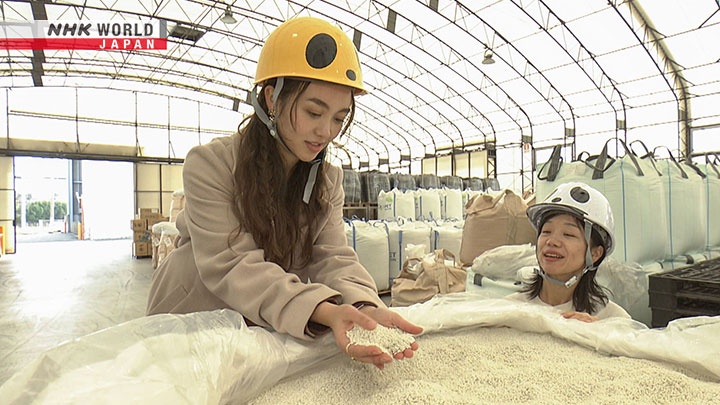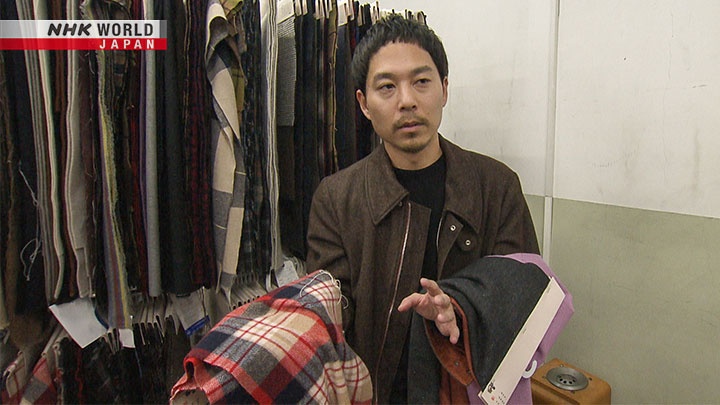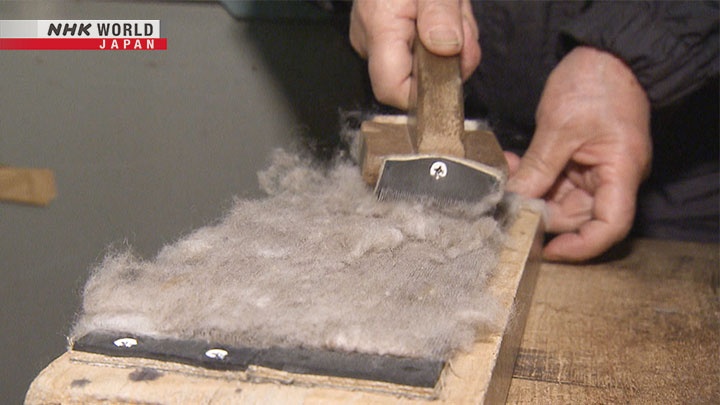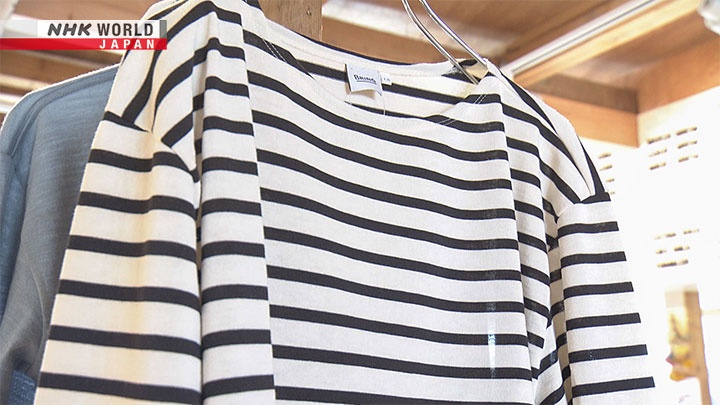Sustainable Circular Fashion
This time, we focus on ethical circular fashion, from a recycled wool brand featured at Paris Fashion Week to polyester products given new life thanks to recycling on the molecular level.




Transcript
Apparel featured at Paris Fashion Week.
These clothes were made of old, reused wool.
Meanwhile, these white shirts were made from used clothes using the power of chemistry.
The fashion world faces problems of overproduction, overconsumption and mass waste.
This time on Ethical Every Day, we check out projects trying to put a more ethical spin on fashion.
- Hey, Alisa.
- Hey, Matthew.
- Hey.
- What's up?
Not much. How do you like my new threads?
- I like it. It really suits you.
- It's very kind of you.
So it just so happens that these very warm and cool looking threads are from recycled wool.
Really? That's very ethical.
There's an area in central Japan where companies make products from used wool.
These kinds of products have been branded with the name Keishichi.
If you look closely, you can actually see that it's made from all these mixed different threads
from a lot of different kinds of used clothing that have been put back together.
- Hey, Matthew.
- Hi House.
Making clothes has a huge impact on the global environment.
Making a single piece of clothing generates the same amount of CO2
as it takes to make 255 plastic bottles, and uses 11 bathtubs of water!
That's why recycling clothing is considered so vital these days.
Yeah, so the Keshichi clothing that I'm wearing right now is one example of clothing made with recycled traditional Japanese techniques.
Let's find out how these clothes are made.
An area including the city of Ichinomiya, Aichi is called Bishu.
Flowing through its center is the Kiso River.
Its plentiful water can be used to dye threads, and wool textile production has flourished here for over a century.
Bishu produces 80 percent of Japan's wool textiles.
It's said to rank alongside the UK's Huddersfield and Italy's Viera when it comes to places famous for wool worldwide.
This wool factory is located outside central Ichinomiya.
It's home to this clothing shop.
Found here are locally made wool items.
Especially popular lately is a certain brand.
These clothes are made by repurposing used wool clothing.
The brand is called Keshichi.
It's the same brand Matthew was wearing.
Keshichi originally refers to material made of 70 percent reused wool threads.
This material has a warmth and softness unique to reused wool.
Using the material means wool products can be made less expensively, and the brand is gaining popularity with young people.
Everything from my waist up is Keshichi.
It's exciting that everything's recycled,
brought back to life.
Keshichi's popularity is thanks in part to designer Hikosaka Yuta from a local textile firm.
Hikosaka turned Keshichi into a brand name, with some items even appearing at Paris Fashion Week.
It has a unique feel unlike regular wool,
and is light and warm at the same time.
That's part of why it's popular,
and why many people keep buying.
I think it's really great material.
How is Keshichi made, exactly?
In Bishu, wool has been reclaimed and reused for about 70 years.
Because Japan relies on wool imported from abroad, used material is not thrown away, and is treated with great care.
Used wool clothing is brought in from across the country, and non-wool materials and scraps are removed.
Next, pros sort the wool material by color.
Here's blue.
And here's red.
The sorted fabrics are then unraveled by a special machine.
Look how fluffy it is!
Since the old colors are used as-is, there's no need for dyeing.
This avoids the use of large amounts of water required for dyeing, as well as chemical dyes, which can lead to pollution.
With that, wool threads of various colors are ready for use.
This is made from four different
colors of Keshichi thread.
If you want to make this from new wool,
you have to dye all four colors.
That takes time and money.
With Keshichi, artisans separate it by color.
If you use those colors, you can make
checkered things right away.
Bishu has practiced these Keshichi techniques for decades, but Hikosaka has brought in his own fresh designs.
And he's trying to market his products by putting their environmentally-friendly, ethical nature front and center.
One reason is that Bishu's wool industry is in decline.
Since inexpensive products from places like China have come onto the market, sales here have declined severely.
The number of wool-related companies here has gone from a high of over 4,000 in the 1990s to about 200 now.
Weaving work's no good anymore.
No work, no money, long hours.
You can work for 8 hours straight
with nothing to show for it.
Feeling a sense of crisis over the decline of the industry here, Hikosaka took action.
How or if Bishu's industry survives depends
on how the people here take initiative.
We need to think about what
conditions are necessary for survival.
In 2019, Hikosaka banded together with Bishu's skilled artisans to turn Keshichi into a brand name.
- I want to bring out this color.
- This color, right?
This is Shibata Wataru.
He's been a Keshichi thread artisan for 60 years.
His workshop has a wide range of fibers in various colors, mostly from recycled wool.
By mixing them in the appropriate amounts, he creates the colors sought by his clients.
Hikosaka has requested a natural wool color.
In response, Shibata mixes a blend of 10 colors, using both wool and synthetic fibers.
Key here are his decades of experience.
I basically know what colors in what
amount will create what the client wants.
If it's off, I'll redo it any number of times.
Here's the finished blend.
Just what Hikosaka ordered!
These new clothes, both stylish and warm, are made possible by the combination of Hirosaka's designs and the artisans' skills.
Since this project began, sales of Keshichi-brand clothes have tripled.
This partnership between Hikosaka and the local wool artisans is just getting started.
The wool was so fluffy and looked like delicious cotton candy.
So after seeing how this is made, I really just adore it, and it was so cool to see people working together, engineering the distinct color.
True. Compare to making new wool, recycling wool is said to be more ethical.
So it is great that is kind of technology in Japan is gaining recognition.
And wool is natural resources, so it can biodegrade at the end as well.
Actually, I am wearing ethical clothing today, too.
It's quite smooth and very light. I love them both.
- And is it recycled, too?
- Yes, exactly.
But not with using traditional technique, but power of chemistry.
The power of chemistry. Whatever do you mean?
It's a process called "chemical recycling."
While clothes are broken down to a level of molecules, then remade.
The molecular level? Pretty fancy!
This sceinece of recycling is getting rather advanced.
Sure is! I actually took a field trip to see how it's done.
Let's look at this new recycling method that's gaining attention from around the world.
Takao is a mountain in west Tokyo.
The shop of a new clothing brand opened at its base in 2023.
It features a range of colorful new clothing - made from "old" clothing!
Old clothes are given new life with an advanced technique called chemical recycling.
- Can't believe they're made from old clothes.
- Did they melt them down or something?
Feels like cotton, and wicks sweat well.
Easy to wear.
- How many are you buying today?
- Today? 18.
It's very innovative.
How do they make shirts like this white one from old clothing?
The factory is in Kitakyushu, Fukuoka, one of Japan's major industrial areas.
I'm here to check out the factory that made clothes to clothes recycling possible.
Let's go see how they do it.
Hello.
So this is the recycling factory
gaining attention worldwide?
Yes. We use chemical recycling,
which breaks down clothes on a molecular level.
That means clothes can be used over and over.
I can't even imagine what it's like.
Can't wait to take a look.
Okay, let's go.
Inside the warehouse are mounds of cardboard boxes.
Are these all filled with clothes?
Exactly.
They've come from all over the country.
Oh, yes, I see Tokyo and all kinds of
places written here.
We receive about 100 boxes a day.
Wow, that's a lot.
First, old clothes are sorted by hand by material.
Tough job.
Yes. They read the labels to
check the material, then sort.
Recyclable 100 percent polyester clothes are then sorted further.
Here we go. 100% polyester.
So these are brought to the factory to be
recycled chemically?
That's right.
Whoa, amazing!
The sorted polyester clothes are brought to this giant facility.
The clothes are added in at the very top,
and are broken down as they move downward.
How does this state-of-the-art chemical recycling process work?
Chemicals are placed in tanks filled with polyester clothes.
When heated, they dissolve the clothes on a molecular level.
The liquid above is dissolved dye and other impurities.
The white substance that separates and settles below is the base substance for polyester.
The white substance undergoes even more processes to become polyester grains.
Wow!
All those colored clothes became
this pure white material.
Removing the colors is one of the
key points of this technology.
The grains are then turned into thread, which can be used to make new clothing.
I hope this tech, which makes clothes more
sustainable, spreads even further!
This also eliminates the need to burn old clothes,
so it leads to fewer CO2 emissions.
It also gets rid of the need for more oil
for polyester, so it connects to conservation.
I think it's important for it to spread.
This may just change the way we think about clothing!
There was quite a lot of clothing that wasn't precicely 100% polyester.
I wonder what happens to them.
Right. It depends on their condition and what they are made of.
But many are reused as pre-owned clothing.
Plus, the company we just saw is working on our waste chemical recycle clothes that aren't 100% polyester.
Also, there are some other companis developing ways chemically recycled clothing made of cotton, too.
Using chemistry is really becoming one way to increase sustainability.
Excellent! Hopefully in the near future, all forms of clothing will be recyclable.
Yeah, that'll be great, right?
This system of reusing resources and circulating them efficiently rather than using new resources is called "circular economy."
That's right, Alisa.
Here is how the circular economy works.
Rendered simply, here's how our current economy looks.
It's a straight line from materials to products that are used then disposed of.
It's called a linear economy.
Here's how we can turn it into a circular one.
Products that were once disposed of are recycled, turned into new materials and resources.
That's a circular economy.
Waste is reduced, and you don't have to produce so many new raw materials.
That ought to be much better for the environment.
Yes, the company we just featured has a project that's trying to bring the circular economy to life.
Let's check it out.
Hello.
This is Nakamura Takayuki.
His brand's clothing recycling system is based on the principles of a circular economy.
At this shop, he's introduced recycling boxes where people can drop off used clothes.
Customers recycle clothes in boxes like this.
We then send them to the factory for recycling.
Nakamura proactively works to link up with other companies in the effort,
including one of Japan's most popular outdoor brands.
Our recycling box is right here.
After a month, it gets pretty full!
It's nice people can easily get a feel for
this sustainable system close at hand.
More firms are coming onboard, including 201 brands.
There are now boxes at over 4,500 shops.
Up until now, it's been rare for different
firms in the same industry to team up.
What was your idea in proactively
linking up firms like this?
When it comes to recycling, one major
issue is the cost of shipping.
If a single firm takes on that cost,
it becomes very expensive.
But if we split the cost of trucks, etc., across
multiple firms, we increase efficiency.
That reduces overall cost.
One more thing.
Japan has a population of 120 million.
To expand recycling, we can't focus only
on our own customers.
That's why we teamed up with other brands,
to promote sustainability widely.
That's the second reason.
Shops and consumers not just selling and
buying, but collecting and recycling.
Everyone's starting to contribute to sustainability.
A virtuous loop.
I feel such a movement beginning.
Yes, we want to create a circular economy.
To create sustainability.
In our case, we're recycling clothing.
The people who have clothing are consumers.
We collect those clothes from them,
recycle them, and make new material.
In Japan alone, it's said 500,000 tons
of clothing are disposed of every year.
We're making part of that sustainable.
It's just a little so far, but we want
to keep increasing the amount.
Here at the shop, I notice that when
people drop off clothing, they're smiling.
You don't normally smile when you're
throwing garbage away, right?
So when I see people smiling like that,
I feel like what we're doing is special.
Fantastic.
Once it gets going, it makes things cheaper because you no longer have to invest in as much new material.
In that sense, it may reduce costs in the long term.
- Reducing costs? That sounds like an easy sell.
- Right.
Recycling clothes in a sustainable way is gaining traction with younger folks, too.
Hello.
Shioya Naho is a member of the student group Carutena.
They upcycle used clothing in order
to help protect the environment.
Nice to meet you.
Thanks for having me.
The group is made up of students from universities and fashion schools, and has 21 members.
So far, they've collected over 800 pieces of clothing to transform into bags and other accessories, which they then sell.
They also hold bag-making workshops in places like schools and libraries.
That's a wonderful bag.
Thank you. It was made from
the uniform of a firefighter.
These pockets are the breast pockets,
used as-is. On the back is the reflective stripe.
Since it's made from a firefighting
uniform, it's quite durable.
When I first started, I was praised for
doing something for the environment,
but many of my friends didn't quite get it.
But now thanks to our efforts, many of them
decided to join in, which is a great feeling.
Alisa and Matthew have both brought some T-shirts from home to upcycle into eco-friendly bags.
Let's see how they do.
First, cut the collar in a circle.
Next, cut the sleeve in a straight line.
That'll form the handle.
- Seems easy enough.
- I was thinking it looked tough.
- You can do it, Matthew!
- I'll try my best!
All you need are some scissors.
No needles or thread are required, so it's easy to do.
We try to keep all the scraps from
these workshops.
They can be used to make coasters
and so on in other workshops.
That's great.
Just like that, the handle is done.
Next, the hem of the shirt is tied together to form the bottom of the bag.
Just cut the hem into long, thin strips, like strings, then tie them together.
Flip it inside out, and it's finished.
Ta-da! Finished. So cute!
It actually looks perfect for
doing some shopping!
You've got some parts hanging out there.
Ah, the shirt was plain black, so you
wanted to create a unique design, huh?
There's no need to sweat small mistakes, so why not try making one of these ethical eco-friendly bags?
If you just say "environmental issues,"
it can feel so big and abstract.
Right. Many people don't know how
they can contribute.
Yes, getting your head around it can be hard.
I had a hard time with that in the past.
I believe we should think about how
to take action for the environment
by considering things near and dear to us,
like imagining the near future,
or enjoying Japan's four seasons.
In my case, fashion is near to me, so that's
how I want to keep approaching the issue.
Protecting the environment by focusing on things near and dear to you.
That's a great way to think about it! See you next time!